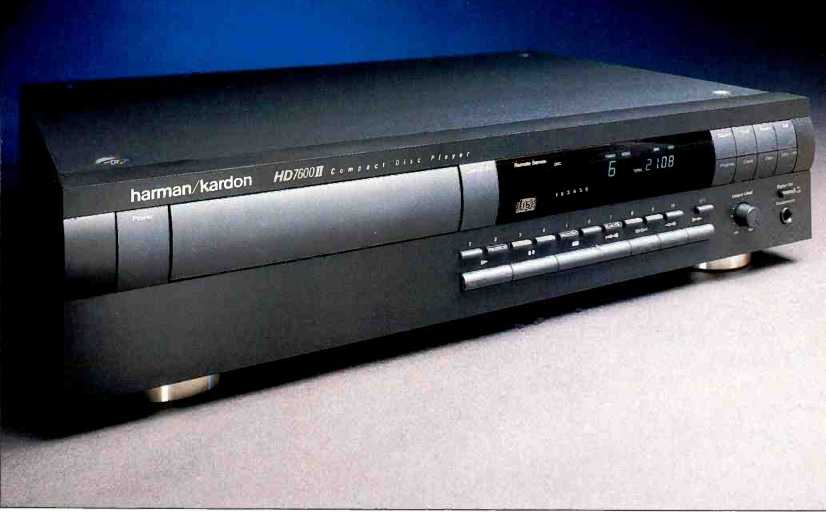
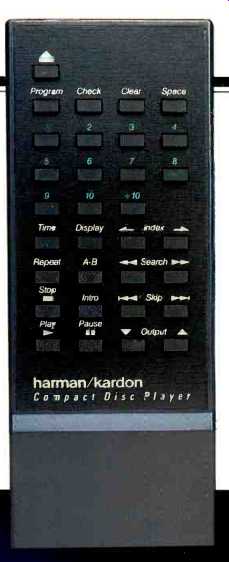
Manufacturer's Specifications:
Frequency Response: 4 Hz to 20 kHz, +0,-0.5 dB.
THD: 0.003%.
S/N: 106 dB.
Dynamic Range: 98 dB.
Low Level Linearity: ±0.2 dB at-90 dB.
Channel Separation: 93 dB.
Line Output Level: 2.0 V.
Digital Output: Coaxial, 0.5 V, peak to peak; optical,-18 dBm.
Number of Programmable Selections: 30.
Power Consumption: 20 watts.
Dimensions: 17 7/16 in. W x 4 1/16 in. H x 14 in. D (44.3 cm x 10.3 cm x 35.6 cm).
Weight: 18.9 lbs. (8.6 kg).
Price: $699.
Company Address: 8380 Balboa Blvd., Northridge, Cal. 91325.
Harman Kardon was one of the first companies to use one-bit D/A converters, and I was very favorably impressed with the way they have implemented this technology. The HD7600II CD player uses bitstream one-bit technology (see sidebar), which involves pulse-width modulation (PWM) in its D/A signal processing. The bitstream converter in the HD7600II operates at 33.8688 MHz. The circuitry also includes a discrete analog output section with 34 separate transistors and 8,480 ILF of power-supply filter capacitance.
Four separate power supplies are employed for the digital, analog, transport, and display sections. About 3 pounds of steel plates are built in to inhibit vibration, and a three-beam laser pickup is used. Among this player's features are a 30-selection program memory, a "music calendar" display, audible two-speed cue and review, index search (via the supplied 27-key remote control), a display on/off switch, coaxial and optical digital outputs, A/B repeat, fixed and variable analog outputs with gold-plated jacks, a head phone output jack, and an output level control.
Control Layout
The "Power" switch is at the extreme left of the front panel, adjacent to the CD drawer; the "Open/Close" button is just to the drawer's right. A large display further to the right shows the current function, selected by means of pushbuttons at the extreme right: "Repeat," "A-B" repeat, "Program" mode, program "Clear," "Intro Scan" (to play the first 15 S of each track or of each programmed track), "Time" (to select either elapsed time of the current track, time remaining for the current track, or time remaining for the disc), and "Check," which performs several functions.
With a disc loaded but not in play, repeatedly pressing "Check" displays the time of each track on the disc. In the program mode, pressing "Check" displays cumulative times of programmed tracks-with one push showing the time of the first track, two pushes showing the times of the first and second tracks, and so on. An eighth pushbutton, "Display," turns the entire display off or on. A motorized "Output Level" control and the headphone jack are at the lower right corner of the front panel, along with a switch that turns the digital output on or off.
A row of numbered buttons (including " +10" for accessing or programming track numbers higher than 10) is arranged horizontally beneath the display area. Beneath them are the usual transport pushbuttons, including those for track skipping and audible fast scanning.
Two functions not found on the front panel are available from the remote control. These are forward and reverse "Index" search, for CDs that have index points marked within tracks, and a "Space" button that inserts a 4-S pause between tracks. This is useful when recording onto cassette for playback in decks having a search feature.
The rear panel of the HD7600II is equipped with pairs of variable- and fixed-level output jacks. There are two digital output jacks as well, one coaxial and one optical.
=======SIDEBAR=========
Multi-Bit and One-Bit D/A Conversion
A digital recording is made by sampling the input signal's voltage several thousand times per second, encoding each of these voltage readings, and then recording the coded data. For CD recording, samples are taken 44,100 times per second and are encoded as 16-bit binary numbers. The D/A converter's job is to turn those 16-bit numbers back into the discrete voltage values of the original signal. Basically, there are two ways to accomplish this.
In a typical multi-bit system, the voltages represented by the presence or absence of 1s in all 16 bit locations are applied simultaneously to a ladder-type converter that sums their out puts. For example, if the sample is:
0001001001011101
…and if the least significant bit corresponds to a value of 1µV, this sample would be equivalent, in microvolts, to:
0+0+0+4096+0+0+512+0+0+64+0+16+8+4+0+1
…or 4,701 µV out of a possible maximum of 65,535 µV (the voltage that would be delivered if each bit in the 16-bit string were a 1).
An alternate way of accomplishing the same conversion would be to use a single-bit D/A converter capable of delivering only 1µV at a time, but to serially (and very, very rapidly) feed that single microvolt along with all the information contained in all 16 bit locations of each sample. In essence (and greatly oversimplified), that is the theory behind the one-bit D/A conversion schemes. While individual approaches to one-bit D/A con version differ, all of the designs must use very high sampling rates and internal clock speeds so that information normally applied to the 16 locations of a ladder-type D/A converter can be applied to the one-bit converter in the same short time (1/44,100 of a second). Benefits claimed for the one-bit conversion technique include superb low-level linearity (a goal not always obtained with more conventional D/A converters unless somewhat costly techniques are used) and freedom from phase irregularities.
-L.F.
Also see: Music of the Bitstream (Jan. 1991)
================
Measurements
Figure 1 shows the frequency response of the HD7600II.
At 20 kHz, response is down a minuscule 0.19 dB for the left channel and 0.13 dB for the right.
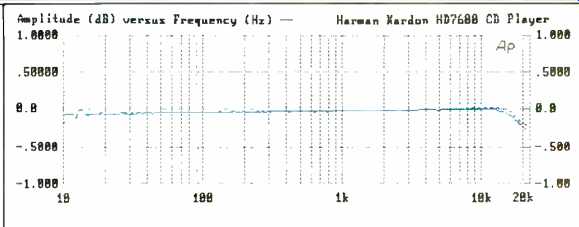
Fig. 1-Frequency response of left channel (solid curve) and right channel
(dashed curve).
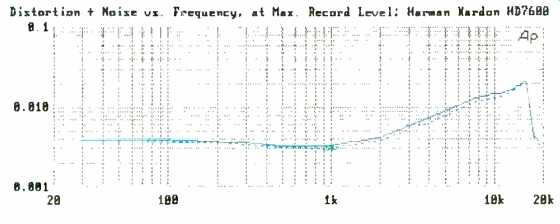
Fig. 2-THD + N vs. frequency at maximum recorded level (0 dB).

Fig. 3-THD + N vs. level for a 1-kHz tone.
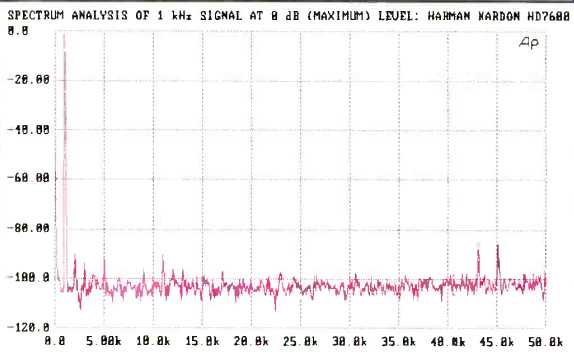
Fig. 4-Spectrum analysis of a 1-kHz signal at 0-dB recorded level.
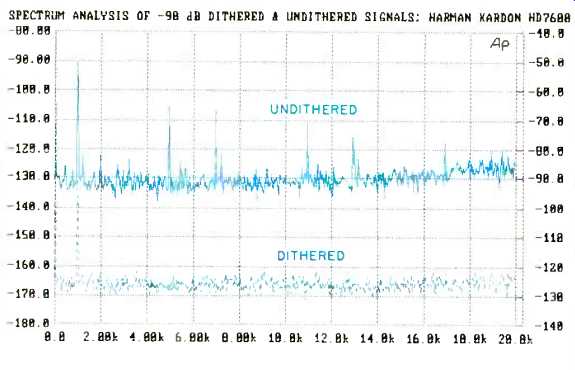
Fig.
5-Spectrum analyses of 1-kHz signals at-90 dB recorded level. Use left-hand
scale for top curve, right-hand scale for bottom curve.
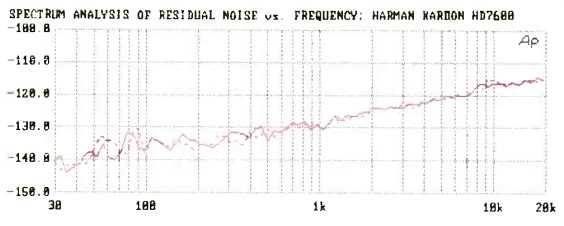
Fig. 6-Spectrum analysis of residual noise when playing "no-signal" test
track.
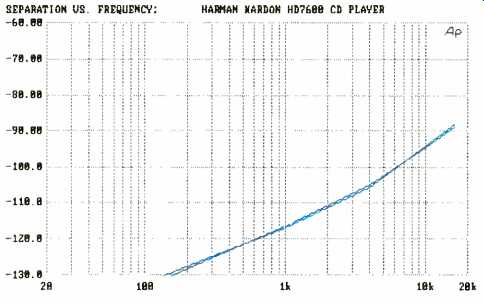
Fig. 7--Separation vs. frequency.

Fig. 8--Deviation from perfect linearity.
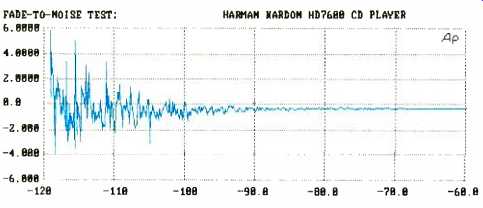
Fig. 9--Fade-to-noise test, using dithered signal.
Figure 2 shows how THD + N varies with frequency, for a signal recorded at maximum level (0 dB). At 1 kHz, for each channel THD + N is slightly higher than 0.003%. A slight rise occurs as higher frequencies are approached, with a maximum reading of 0.022% at around 15 kHz. Figure 3 shows how THD + N varies with recorded signal level. The results are in dB, referenced to maximum recorded level.
Credit must be given to Harman Kardon's discrete output stages, which introduce only a very slight increase in THD + N as the highest output levels are reached. Many CD players exhibit a steep rise in THD + N as higher and higher output levels are approached. In the case of this CD player, THD + N ranges from-93.5 dB to-92 dB over most of the test signal's amplitude range, and it increases to only-89.3 dB or one channel and about-90 dB on the other at maximum level. These readings at 0 dB correspond to 0.00342% and 0.00316%, almost perfect correlation with the results at 1 kHz for the 0-dB signal seen in Fig. 2.
Figure 4 is a spectrum analysis of a 1-kHz signal at 0 dB.
The signal itself is seen as the tall spike at the left, while harmonic components are visible at 2, 3, 5, 9, and 11 kHz.
Most of these components are down by about 90 dB or more. Notice the two little "blips" that show up at around 43.1 and 45.1 kHz. They are obviously minute beats caused by the interaction of the 1-kHz signal with the CD's 44.1-kHz sampling rate. These beats are more than 85 dB below maximum recorded level, however, and even if their level were higher, their frequency would make them inaudible.
The ability of a properly dithered signal to exhibit lower distortion than an undithered signal of the same amplitude (-90 dB) is dramatically demonstrated by the spectrum analyses in Fig. 5. Note the high levels of fifth-, seventh-, and 11th-order distortion components for the undithered signal. By contrast, these components virtually disappear into the noise when a dithered signal is used. For the undithered signal, the fifth-order distortion component, 5 kHz, is down some 104.5 dB, whereas for the dithered signal, distortion plus noise at that same frequency is down a full 128 dB-an advantage of 23.5 dB! A-weighted S/N, using the "silent" track of my CBS CD-1 test disc, measured exactly 109 dB for each channel, well above the 106 dB claimed by Harman Kardon. A spectrum analysis of the output from that same track is plotted in Fig. 6. This player's excellent isolation of power-supply components from the rest of the audio circuitry is amply demonstrated by the fact that there are only the barest "bumps" in the plot at 60 and 120 Hz. At the power-line frequency, these small peaks are some 132 to 134 dB below maximum recorded level.
Stereo separation, plotted in Fig. 7, is virtually identical for both channels, measuring 116.6 dB at 1 kHz. At 16 kHz, separation decreases to 87.8 dB.
Figure 8 shows deviation from perfect linearity with undithered signals ranging from 0 to -90 dB and dithered signals ranging from -70 to -100 dB. It is interesting to note that although the deviation is certainly minimal for undithered signals (less than 0.5 dB of error at -90 dB), the use of dithered signals at even lower levels results in a deviation of no more than -0.2 dB at -100 dB! Again, this illustrates how effective a bit of properly applied dither can be in reducing quantization distortion in low-level signals.
(Engineers in major recording studios, take note!) Figure 9 is my usual plot of a dithered fade-to-noise signal. Again, signal levels are almost perfectly accurate until they become buried in the residual noise, below about -105 dB. This plot enabled me to assess the EIA dynamic range of the player, approximately 108 dB. Measured by the EIAJ method, dynamic range was 94 dB.
A couple of additional spot checks I made while the player was on the lab bench included a check of SMPTE-IM distortion, which was 0.0066% for either channel, and frequency or clock accuracy, which was "off" by an insignificant -0.0021%. My check with a unit-pulse test signal (not shown) demonstrated that the HD76001I does not invert signal polarity.
Use and Listening Tests
The Harman Kardon HD7600II's linearity is superb. Its distortion is extremely low. Frequency response is as flat as anyone could hope for, and residual noise is inaudible.
Furthermore, the sound quality couldn't be better, as I discovered when I played some of my most treasured CDs, including some that had sounded a bit harsh on earlier players. I used to blame this harshness entirely on the recording engineers. Now I know better; some of what I complained about was entirely the fault of the CD players I used. Well, that harshness is gone when those discs are played on the HD76001I.
Tracking ability, however, was less than exemplary, at least for my sample. I would hasten to add that this may or may not be true for other units, since good tracking depends on many factors, not the least of which is accurate alignment and adjustment of the laser pickup assembly. In any case, the player I tested mistracked when a defects disc presented it with "missing" data extending just 0.5 mm along a track. Almost every player I've tested over the last couple of years has been able to track through data gaps of at least 0.7 mm, and some have even tracked through 1.2 or 1.5 mm of missing digital data. Perhaps some jarring in shipment caused the problem with my sample. Even if that is not the case, however, I can recommend this CD player with its bitstream technology and its superb sound quality to anyone who is more than a casual listener to music but can't afford the kilobucks demanded by other high-end players that sound as good as this model from Harman Kardon.
-Leonard Feldman
(Source: Audio magazine, Feb. 1992)
Harman/Kardon HD800 Compact Disc Player (Jan. 1989)
Music of the Bitstream (Jan. 1991)
Harman/Kardon Citation 16 Basic Amplifier (Dec. 1976)
= = = =